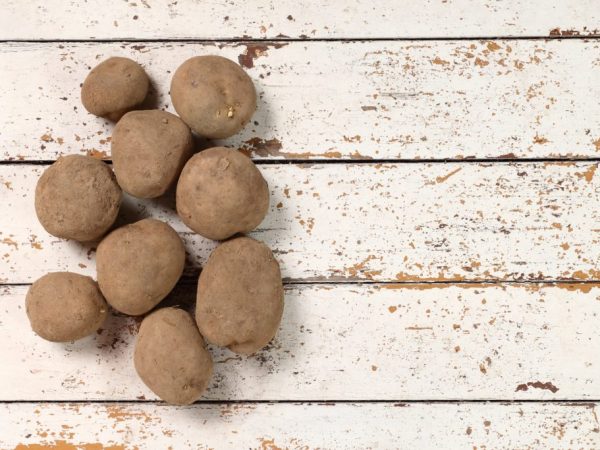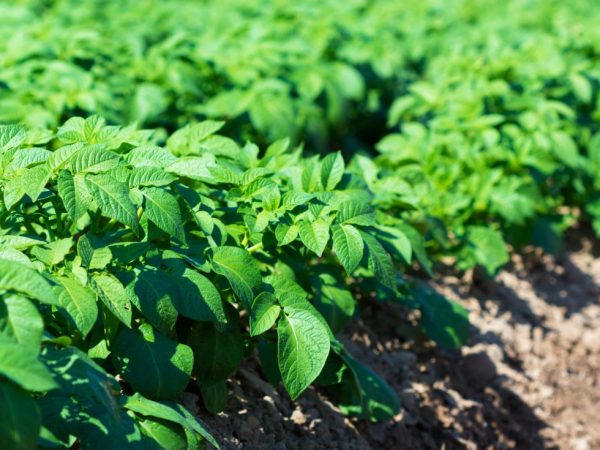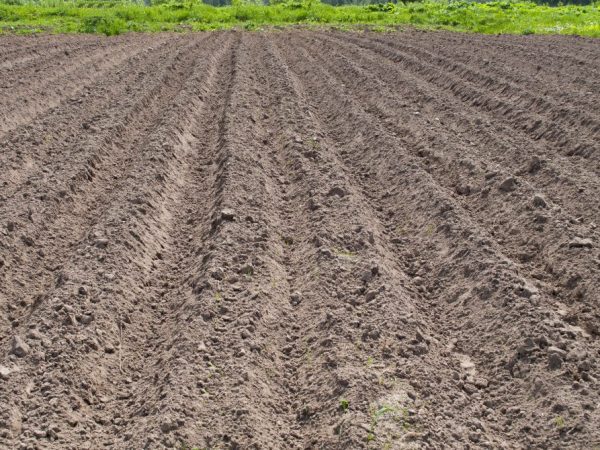Characteristics of Kiwi potatoes
The main ingredient in many dishes is, of course, potatoes. The variety of varieties allows you to choose vegetables that are ideal for cooking, frying, stewing and other equally delicious dishes. To enjoy young potatoes, early vegetables are grown, and varieties of a later ripening period are taken for winter storage. But there is a variety, the description of which even agronomists know little about, this is the Kiwi potato. It is rarely found in stores and even more so in markets, but if gardeners have managed to purchase and grow it, then they give the most positive feedback to this vegetable.

Characteristics of Kiwi potatoes
Characteristics of potatoes
The variety was created by the usual breeding method. And the fact that it is not damaged by pests only confirms that without the creation of GMOs, fantastic results can be achieved without disrupting the genome of plants and animals. The hereditary material contained in the cells remains the same and carries biological information concerning all the characteristics of organisms.
The Kiwi variety is practically not demanding on the composition of the soil and is capable of bearing fruit on loam and sandy loam soils. A good yield of marketable products is obtained in sod areas.
The main difference from other varieties is the appearance of the potato. The peel of the vegetable has a net-like structure similar to that of kiwi fruit. There are other interesting features as well.
- Kiwi potatoes are late-ripening species.
- It can be grown throughout the country.
- The marketable yield of tubers is more than 95%.
- The variety is transportable.
From the time of emergence to full maturation, at least 130 days pass. For harvesting young potatoes, these terms can be reduced, but then the yield from one hundred square meters will not be more than 200 kg.
With proper care, 1kg of planting material will yield more than 20kg of production. This is a very good result. But its result is influenced by soil moisture. In dry weather, constant watering is required, at least 4 times during the growing season, as recommended by the plant care description.
The characteristic given by agronomists says that this variety is extremely rare and the price of planting tubers is high.
If there is an opportunity to purchase seed potatoes, then it is suitable for planting almost throughout the country. But most often, such potatoes are found in the gardens of residents of the middle zone and regions of the Kuban, in the Moscow region and in the Krasnodar Territory.
Advantages of the Kiwi variety
Collected a lot of different information regarding the characteristics of this potato.
- Propagated only by tubers.
- It has immunity to almost all viruses and diseases and pests.
- To fertilize the plots, organic matter, phosphorus and potassium are required.
- Possesses exceptional productivity.
- He is unpretentious in care.
Heat treatment of tubers during cooking, it is desirable to carry out at least 40 minutes. During this time, the potatoes are completely boiled down and a lush mashed potatoes are obtained.
Each person has his own concept of quality and on its basis the characteristics of the fruit are formed. But most people agree that Kiwi tastes good on the periphery of the tuber, but the middle has little to no taste.
The specific characteristic of this vegetable allows only tuberous cultivation. We have never planted seeds to obtain a high-grade varietal material. But this is not required. All tubers of this variety grow quite large fruits, weighing about 300g. Medium potatoes reach a weight of 200g, but there are no small tubers at all.
The description of the positive qualities of the vegetable can be ended with the amazing ability of the plant to repel pests. Some ordinary people are inclined to argue that this property distinguishes only GMO varieties. But with respect to the Kiwi potato, you can be completely sure that it is not a genetically modified organism.
Disadvantages of Kiwi potatoes

There are very few disadvantages of this variety.
A small disadvantage that can be easily corrected is that the potatoes need to be boiled for a long time. Abundant watering, when it is necessary for the moisture to reach a depth of 0.5m, can also be considered a nuisance. But these are only the features of care that every gardener should be ready for.
Description of the bush
The potato variety Kiwi has tall stems that grow taller than 80cm. The bush bears up to 6 stems, ribbed, with a large number of branches of the second order. They are green in color, with an admixture of yellowness in the lower part.
The stems are covered with leaves from the very base of the bush. The leaf plates are slightly dissected, they are of the potato type, with notches along the edge. Emerald green leaves are rough, covered with hairs.
Simple inflorescences form at the tops of the stems. Flowers, fused with petals in the area of the corolla base, reach 2 cm in diameter. Their color is bright lilac. The stamens are yellow and compact. The pistil protrudes 0.5 cm.
The plant is pollinated naturally and sets a small amount of berries. The seeds ripen poorly and the berries, in most cases, fall off. They are of no use because the seed propagation of the variety is not suitable for the plant in question.
Description of tubers
The description of tubers can begin with the fact that more than 15 fruits ripen in a fruit nest, elongated in shape with rounded poles. The peel is thin, has a mesh structure, rough to the touch. The color of the tubers is light brown. The eyes are small, located in barely noticeable depressions.
The pulp is firm, white, with a tint of amber. The starch content of tubers is about 17%, the sugar content is low - 0.1%. The cut does not darken for a long time.
During mechanical harvesting, tubers are not damaged by impact or compression. Abrasions are quickly smoothed out by tightening the wound surface with a dry starchy substance. The site of injury does not lend itself to decay. Ripe tubers are well stored for a long time. According to the reviews of experienced gardeners, this period can reach 2 and 3 years. But would ordinary vegetable lovers want to check this out in practice? They grow potatoes for consumption, not long-term storage.
For salads, it is necessary to cook vegetables a little less, then the fruits will retain their structure and will not crumble when cutting. In the first courses, potatoes can be cooked as the hostess likes. If the household loves thick soups, then they cook them longer, if they prefer that the slices retain their shape, then they cook the dishes for less time.
Some consumers claim that this vegetable is tasteless, while others say it tastes sweet and pleasant.
Biocell is a part of tubers, it is not absorbed by the digestive system of the wireworm and the golden cyst nematode. The leaves of the potato are covered with hairs that interfere with the laying of eggs by the Colorado potato beetle. And this hairiness does not allow adult insects to get to the leaves and eat them.
Keeping quality and resistance to damage make it possible to transport products over long distances for sale. This means that exotic Kiwi potatoes will grow not only among potato growers who collect rare varieties, but also on the plots of other people.
Preparing the soil for planting

The soil needs to be prepared
A plot for potatoes is prepared in the fall. Some potato growers bring in up to 45 buckets of rotted manure per one hundred square meters and dig up to a depth of 20 cm. You can add ammonium nitrate and potash fertilizers to the manure, 20 g of each substance.
The second method consists in sowing green manure in the area such as:
- winter rye;
- mustard;
- legumes;
- alfalfa.
All plants are buried in the soil during digging, in the fall. Only winter crops are pruned with a hoe in the spring, before the tubers are planted.
When the soil temperature reaches 10 ° C at the planting depth, then you can prepare the site by marking it in rows. They are oriented parallel to the North-South line. Leave at least 60 cm between the rows, tk. the bushes of the plant are lush and spreading. The distance between the holes is about 30cm, and their depth is 12cm.
Some experts recommend growing Kiwi potatoes using the Dutch method: double ridges. Each ridge consists of 2 rows, the distance between which should be about 30 cm, as well as between the tubers. At least 70 cm is left between the ridges so that the plantings can be processed with small garden equipment. If there is no such technique, then the work is carried out with a hoe.
Tuber preparation
One month before planting, it is necessary to remove the seed potatoes from storage and warm up at a temperature of 20 ° C for about 2 days. Then put the tubers in boxes in 2 rows and leave for germination. The room temperature must not drop below 10 ° C. The boxes are exposed to light for landscaping to help the sprouts grow stronger.
At a height of 3 cm eyes, potatoes can be planted in the ground, if there is no threat of frost. You can process it with growth stimulants such as Epin. No insecticide treatment is needed.
Plant care
Every gardener, even a beginner, can provide potatoes with everything they need for good fruiting.
- Water the plantings at least 3 times.
- Loosening of the soil is carried out after watering or rains.
- Weeding is carried out as the weeds grow.
- With a period of 10 days, top dressing is carried out: 3 times per season.
If it rains a lot, then there is no need to water the Kiwi potatoes. Only when the soil dries out at a depth of 25 cm can the area be watered.
It is necessary to loosen the soil carefully. The bulk of the crop is located at the surface. With the Dutch cultivation method, hilling is not carried out. It's just that both sides of the ridges are covered with soil from the row spacing to a height of up to 25 cm.
The description and characteristics of the plant says that fertilizers are applied in the middle of the ridges or near each bush in a rainy summer. In dry months, it is combined with watering. For top dressing, complex mineral fertilizers are taken, including urea, potassium salts and phosphates.
For organic dressing, solutions are prepared independently. Manure and water are introduced into a large container 1: 1, leaving for 2 weeks, in a warm room, for fermentation. The fermented mixture is again diluted with water 1:10 and poured over the potatoes.
Harvesting and storage
Harvesting is most often carried out at the end of autumn, when the tubers reach technical ripeness. 2 weeks before this, the stems are cut to a height of 10 cm and the tops are removed. After harvesting, the potatoes are dried and sorted. They immediately get rid of tubers on which there are visual signs of rot. Cuts are dried and stored separately or consumed.
The rest of the product is sorted out for seed potatoes and for storage. Both parts are brought into the cellars. In winter, you need to occasionally inspect potatoes and remove rotten potatoes.
Diseases
The plant is unique in that it is not damaged by viruses of nightshade crops such as:
- late blight;
- common scab;
- macrosporiosis;
- leaf mosaic;
- circular fruit rot.
Even with an excess of moisture in the soil and air, infection of potatoes with these viruses almost never occurs.
Conclusion
When grown on their own plots, the Kiwi potato variety can pleasantly surprise the gardener. Nice-looking, interesting structure, tubers will be liked in various types of culinary processing. The main argument for this variety to settle in your garden will be an exceptionally high yield. And the factor that no pesticides are needed for its successful vegetation will make it possible to put on the table dishes that are environmentally friendly and tasty.


